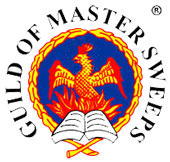Sweeping Your Own Chimney
To Sweep Your Chimney, You Will Need..
- Large dust sheet
- Torch
- A good quality sweeps brush
- Set of universal rods (3/4 inch)
- Adapter for rods brush (normally adapts to a Whitworth thread)
- Mask and gloves
- An old bed sheet with a 3cm square hole cut in the middle
- Vacuum with HEPA filter
- Smoke matches or pellets
- Blow torch/ hair dryer/similar
- Reel of Duct tape
- A friend (needed for when you use your smoke pellets/matches)
Before you read on, please be aware that it is always a preferable option to hire a professional, qualified chimney sweep to do this job. Many household insurance policies insist that a certificate of sweeping for homes with working chimneys are needed to keep them valid. These certificates must and can only be issued by sweepers that are backed by an official chimney sweeping association (e.g. the Institute Of Chimney Sweeps). Doing the job yourself will not be enough for you to receive one of these. and so may invalidate your insurance.
A good, professional chimney sweep will never leave any mess behind, and will do the task to the highest possible standard. This means minimal effort for you, no risks to your own safety and nothing to clean up afterwards.
Bearing all of this in mind, some people will insist on cleaning their chimneys themselves (especially if they are living in an area with few or no local chimney sweeps), so this is a guide for them. It is better to do a job you already insist on doing anyway with easy-to-follow and safety-conscious instructions than guessing as you go.
Cleaning Your Chimney – Instructions
The chimney type that this step-by-step guide covers is a basic one with no cowls fitted and an open clay pot.
- Put your mask and gloves on ready.
- Protect your floor from getting dirty by laying the dust sheet in front of your fire place
- Using the torch, shine the light up the chimney to work out the size of the flue.
- Cut the brush down to size. You will need it to be slightly wider that the flue.
- Tape your sheet with the hole in it to the top of the fireplace’s opening with lots of duct tape, ensuring that the sheet falls to cover the whole opening.
- Place the cut-down brush inside the fire opening.
- Push your leading rod through the hole in the bed sheet.
- Using your arm, hold the brush upright, then connect the leading rod to it.
- Using more duct tape, secure the sheet around all of your fireplace opening’s edges. This is to prevent dust and soot from falling into the room and making a mess.
- Push the leading rod up the chimney and connect another when needed, always turning to the right. This will move your brush up the chimney and dislodge any dirt and soot.
- Keep going until you reach the top of the flue, and when bringing the rod back down, unscrew the pieces as you go.
- Grab your torch and have a look at the job you have done. If you’re not happy with it, repeat the last few steps until your flue is satisfactorily clean.
- Using a heat source such as a hairdryer or blowtorch, warm the chimney. You will need to point your blow torch/ hair dryer directly up the flue for around eight minutes.
- Light the smoke match or pellet and place it inside the fireplace’s opening. The smoke should go straight up the chimney. If this isn’t the case, you may need to call in a professional to rectify it.
- Ask a friend to stand outside your house and check whether there is smoke coming out of more than one chimney pot. If there is, this could mean that you have a leak and need to request the services of a qualified chimney sweep.
- Using a vacuum cleaner and/or a dustpan and brush, clean up the debris from the fireplace. Job done!
Additional note: If you have a working chimney/fireplace/stove, you will need to ensure that CO2 alarms are fitted in every room that your chimney runs through (including any loft space). This is essential for you and any other of your home’s occupants’ safety.
I hope that this guide has been helpful. If you require any more guidance, then please don’t hesitate to get in touch!


